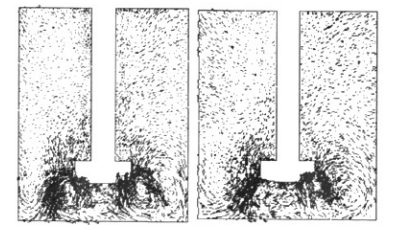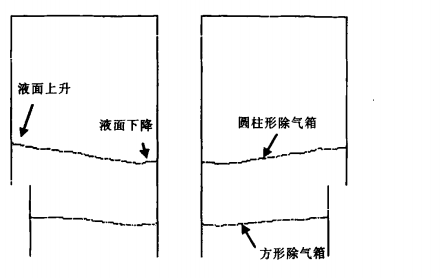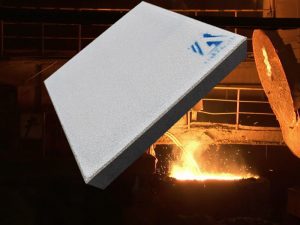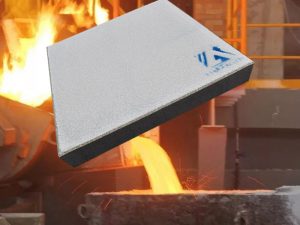How to optimize rotary jet degassing process for degassing units part D
3.3 Influence of the form of the degassing unit on the gas-liquid two-phase flow field
(a) Square degassing unit b) Cylindrical degassing unit
Figure 6. Liquid phase velocity distribution in a longitudinal section of different types of degassing units

Fig. 6 is the liquid phase velocity distribution of a certain longitudinal section (phase angle θ=0°) in the degassing unit of different forms, in which the clearance from the bottom is C=150 mm and the bubble diameter db=1.0 mill. It can be seen from Fig. 6 that whether a square or cylindrical degassing unit is used, the distribution shape of the liquid phase velocity field, the position, and size of the vortex in the degassing unit are relatively close, that is, the form of the degassing unit has no influence on the distribution of the liquid phase velocity field. Big.
Figure 7 shows the fluctuation of the free liquid surface in different forms of degassing boxes. For the convenience of comparison, only a partially enlarged view of the free liquid surface θ=0° is given. The parameters of rotary injection are the same as in Fig. 6.
Figure 7 Free liquid surface in different types of degassing units
It can be seen from Figure 7 that when a cylindrical degassing box is used, the liquid in the degassing unit is thrown to the side wall under the action of centrifugal force, so that the liquid in the side wall area rises along the wall of the device, while the liquid level in the central part drops, forming a When a large vortex occurs, a vortex phenomenon occurs, which is consistent with the actual situation. When a square degassing unit is used, although there is liquid level fluctuation at the free liquid surface, no vortex phenomenon occurs. Due to the swirling phenomenon, the hydrogen absorption on the surface of the aluminum melt is greatly intensified, and it may be mixed with fine oxide inclusions. Therefore, the cylindrical degassing box is hardly used in actual production.
Fig. 8 shows the gas volume fraction distribution of a certain longitudinal section (phase angle θ= 45°) in different forms of degassing units, and the parameters of rotary injection are the same as those in Fig. 6.

Fig. 8 Distribution of gas volume fraction in a longitudinal section of MW in different forms of degassing unit
Analysis of Fig. 8 shows that the form of the degassing unit has a great influence on the volume distribution of the gas phase. The cylindrical degassing unit is used, and most of the gas is gathered around the rotating rod, and the gas hold-up rate in the periphery of the degassing unit is very low, which is not conducive to the full contact of the gas-liquid two phases. When a square degassing unit is used, the gas holdup in most areas of the degassing unit is improved, and the fluctuation at the inner surface of the liquid is relatively small, which is conducive to the full mixing of the gas and liquid phases and is conducive to the melting of the aluminum melt. In addition to hydrogen.
4 Conclusion
1) The gas is easy floating from the central area of the degassing unit to the free liquid surface and escapes, resulting in that the aluminum melt in the side wall area cannot be effectively contacted with a sufficient amount of argon gas, which is not conducive to hydrogen removal, and this is at the 45° phase angle position. A phenomenon is more serious.
2) The clearance from the bottom has a certain influence on the gas distribution in the degassing unit. When the clearance from the bottom is small, the tendency of gas to blow down from the pores to the aluminum melt is enhanced, which is beneficial to the removal of hydrogen from the aluminum melt.
3) Reducing the diameter of the bubbles can effectively improve the gas distribution in the entire degassing unit and improve the hydrogen removal effect.
4) The use of a cylindrical degassing unit is easy to cause swirl, which makes the surface of the aluminum melt intensify the absorption of hydrogen; the use of a square degassing unit can not only avoid the swirling phenomenon but also improve the distribution of the gas phase in the degassing unit, which is beneficial to aluminum Dehydrogenation of melts.




